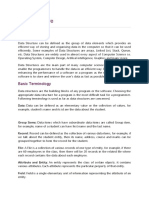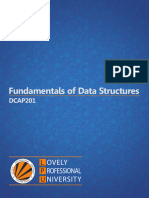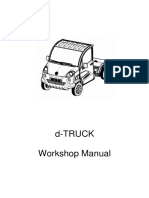0 ratings0% found this document useful (0 votes)
6 viewsIntroduction to Data Structures v2 12042022
The document provides an introduction to data structures, explaining basic terminology such as data, entities, and information, as well as the classification of data structures into primitive and non-primitive types. It discusses various data structures like arrays, linked lists, trees, stacks, queues, and graphs, along with their operations including traversing, searching, inserting, deleting, sorting, and merging. Additionally, it highlights the importance of algorithm efficiency in terms of time and space complexity.
Uploaded by
Manmeet SinghCopyright
© © All Rights Reserved
Available Formats
Download as PPTX, PDF, TXT or read online on Scribd
0 ratings0% found this document useful (0 votes)
6 viewsIntroduction to Data Structures v2 12042022
The document provides an introduction to data structures, explaining basic terminology such as data, entities, and information, as well as the classification of data structures into primitive and non-primitive types. It discusses various data structures like arrays, linked lists, trees, stacks, queues, and graphs, along with their operations including traversing, searching, inserting, deleting, sorting, and merging. Additionally, it highlights the importance of algorithm efficiency in terms of time and space complexity.
Uploaded by
Manmeet SinghCopyright
© © All Rights Reserved
Available Formats
Download as PPTX, PDF, TXT or read online on Scribd
You are on page 1/ 26
Introduction to
Data Structures
Ms. Divya Verma
Assistant
Professor,IT
Contents:
Introduction to Data Structures
Classification
Operations of Data Structures
Basic Terminology: Elementary
Data Organizations
1)Data:
Simply values or set of values.
Data item refers to a single unit of values.
Data items that are divided into sub items
are called group items,those that are not
are called elementary items.
Example-Employee’s name may be
divided into first name,middle name and
the last name.
Collections of data are frequently
organized into a hierarchy of fields,records
and files.
II) Entity:
Something that has certain attributes or
properties which may be assigned values.
The values may be either numeric or non
numeric.
Example:
Attribute Name RollNo. Marks
Values ABC 001 90
DEF 002 100
Entities with similar attributes form an
entity set.
Each attribute of an entity set has a
range of values.
III)Information:
Meaningful or processed data.
IV)Field:
A single elementary unit of
information representing an
attribute of an entity.
V)Record:
Collection of field values of a
given entity.
VI)File:
Collection of records of the
Records may be classified according
to length:
i) fixed-length records
Ii) variable-length records
In fixed-length records, all the
records contain the same data items
with the same amount of space
assigned to each data item.
In variable-length records, file
records may contain different
lengths.
The organization of data into fields,
records and files may not be complex
enough to maintain and efficiently
process certain collections of data. For
this reason, data are also organized into
more complex types of structures.
The study of such data structures,
which forms the subject matter,
includes the following three steps:
Logical or mathematical description of the
structure
Implementation of the structure.
Quantitative analysis of the structure that
determines the memory needed to store the
structure and the time requirement to
process the structure.
Data Structures:
Introduction
Way of collecting and organizing data in
such a way that we can perform
operations on these data in an efficient
way.
Defn: Logical or mathematical model of a
particular organization of data is called a
data structure.
The choice of a particular data model
depends on two considerations-
It must be rich enough in structure to mirror
the actual relationships of the data in the real
world.
It must be simple enough that one can
effectively process the data when necessary.
Classification of Data
Structures:
Primitive:
Basic data types such as integer, real,
character and boolean are primitive data
types.
These data types consists of characters
that cannot be divided.
Directly operated upon by machine level
instructions.
Non-primitive:
Example: processing of complex numbers-
not many computers are capable of doing
arithmetic on complex numbers.
Linked-lists, stacks, queues, trees etc are
examples.
Based on the structure and
arrangement of data, non-primitive
data structures are further classified
into linear and non-linear.
Linear: Elements form a sequence or
a linear list.
Data is arranged in a linear fashion
although the way they are stored in
memory may not be sequential.
Non-linear: data is not arranged in
sequence.
The insertion and deletion of data is
therefore not possible in a linear
fashion.
Arrays
The simplest type of data structure is a
linear or one-dimensional array.
A list of finite number n of similar data
elements referenced respectively by a set
of n consecutive elements,usually 1,2,3...n.
Example: if A is an array,then elements of
A are denoted by a1,a2,a3,....an
Or A(1),A(2),A(3),....A(N)
Or A[1],A[2],A[3],....A[N]
Hence the number k in A[k] is called the
subscript and A[k] is called the subscripted
variable.
2-Dimensional array is a
collection of similar data
elements where each element is
referenced by two subscripts.
Example: Matrices.
Example:
1) Lets consider an array named
student consisting of 5 elements.
Then each element can be
referenced by a subscript.
Student
Abc student[1]
Def student[2]
Ghi student[3]
Jkl student[4]
Mno student[5]
2)Similarly, 2-D array is denoted by 2
subscripts,one for the row and the other
one for the column.
1stsubscript denotes the store and 2nd
denotes department.
Sales[1,1]=2872 rows -> horizontal lines
Sales[1,3]=3211 columns-> vertical lines
Sales[3,2]=1017
Linked Lists
Collection of different nodes
where each node is connected to
the next node.
Example:
The data here
is stored in a
table using 2
columns but this is
not efficient.
Another way of storing the data
is to have a separate array for
the salesperson and an entry
(called a pointer) in the customer
file which gives the location of
each customer’s salesperson.
Here,a pointer is used to
point to the location of the
corresponding salesperson.
An integer used as a pointer
require less space than a
name,hence it saves space.
Suppose the firm wants the list of
customers for a salesperson,then
the entire customer file would
have to be searched.
Another way would now be to
have a set of pointers give the
position of the customers.
The main disadvantage of this
representation
is that each salesperson
may have may pointers and
the set of pointers will change
as customers are
added/deleted.
Another very effective means to
store the data is through linked
lists. The salesperson has one
pointer which points to the first
customer,whose pointer in turn
points to the 2nd customer and so
on,with the salesperson’s last
customer indicated by 0.
Trees
Used to store the data of
hierarchical relationships
Stacks
LIFO i.e Last in First Out.
Insertions and deletions can take
place only at one end. i.e. Top.
Example: Book shelf
Queue
FIFO i.e. First In First Out
Linear list in which deletions can
take place only at one end i.e.
Front of the list and insertions
take place only at rear of the list.
Example:
Queue waiting at the bus stop.
Graphs
Data sometimes contain a
relationship between elements
which is not hierarchical in
nature.
Data Structure Operations
Data contained in data structures
is processed by means of certain
operations.
The particular data structure that
one chooses depends largely on
the frequency with which specific
operations are performed.
1)Traversing: accessing each element
exactly once so that certain elements can be
processed.
2)Searching: finding the location of the
record with a given key value, or finding the
location of all records which satisfy one or
more conditions.
3) Inserting: adding a new record to the
structure.
4)Deletion: Removing a record from the
structure.
5)Sorting:arranging the records in some
logical order.
6)Merging:combining the records in two
different sorted files into a single sorted files.
Algorithm-Time Space
Trade off
Algorithm is a well defined list of
steps for solving a particular
problem.
The time and space it uses are
two major measures of the
efficiency of an algorithm.
The complexity of an algorithm is
the function which gives the
running time or space in terms of
the input size.
You might also like
- Data Structures & Algorithms Interview Questions You'll Most Likely Be AskedFrom EverandData Structures & Algorithms Interview Questions You'll Most Likely Be Asked1/5 (1)
- Data Structure and Algorithms (CSC-216)No ratings yetData Structure and Algorithms (CSC-216)27 pages
- Chapter 1 Introduction to datastructure and algorithmNo ratings yetChapter 1 Introduction to datastructure and algorithm10 pages
- Subject: Bcs-303 Data Structure & Algorithms Class: Sybsc (CS) - Semester IiiNo ratings yetSubject: Bcs-303 Data Structure & Algorithms Class: Sybsc (CS) - Semester Iii12 pages
- Lec01 (Week 1) - CS 232 - Data StructureNo ratings yetLec01 (Week 1) - CS 232 - Data Structure25 pages
- SUBJECT NAME:Data Structures and Algorithms Subject Code: Scsa1205 Unit: INo ratings yetSUBJECT NAME:Data Structures and Algorithms Subject Code: Scsa1205 Unit: I82 pages
- Data Structures Using C (Csit124) Lecture Notes: by Dr. Nancy GirdharNo ratings yetData Structures Using C (Csit124) Lecture Notes: by Dr. Nancy Girdhar33 pages
- CSE 134: Data Structure Lecture #1: Mohammad Reduanul HaqueNo ratings yetCSE 134: Data Structure Lecture #1: Mohammad Reduanul Haque26 pages
- CSE 134: Data Structure Lecture #1: Mohammad Reduanul HaqueNo ratings yetCSE 134: Data Structure Lecture #1: Mohammad Reduanul Haque26 pages
- 0.introduction To DS - Sorting - SearchingNo ratings yet0.introduction To DS - Sorting - Searching79 pages
- Dcap201 Fundamentals of Data StructuresNo ratings yetDcap201 Fundamentals of Data Structures270 pages
- The Specifications of DH9920C: Details PDFNo ratings yetThe Specifications of DH9920C: Details PDF1 page
- Motor Feeder Cable & Cable Tray Sizing and DataNo ratings yetMotor Feeder Cable & Cable Tray Sizing and Data5 pages
- Topics To Be Covered: Binary Digital Modulation M-Ary Digital Modulation Comparison StudyNo ratings yetTopics To Be Covered: Binary Digital Modulation M-Ary Digital Modulation Comparison Study26 pages
- The Mode of Transportation Utilized by Medical Technology Students of Emilio Aguinaldo College - ManilaNo ratings yetThe Mode of Transportation Utilized by Medical Technology Students of Emilio Aguinaldo College - Manila12 pages
- Lag, Lead, Lead-Lag - Compensation in Control System100% (2)Lag, Lead, Lead-Lag - Compensation in Control System11 pages
- Session 2 Understanding The Role of The PPST in RPMSNo ratings yetSession 2 Understanding The Role of The PPST in RPMS22 pages
- Eagle Quantum Premier 8 Channel Relay Module Model EQ3720RM: Specification DataNo ratings yetEagle Quantum Premier 8 Channel Relay Module Model EQ3720RM: Specification Data4 pages
- Complete Download CC Certified in Cybersecurity All-in-One Exam Guide Steven Bennett PDF All Chapters100% (2)Complete Download CC Certified in Cybersecurity All-in-One Exam Guide Steven Bennett PDF All Chapters57 pages
- Industrial Engineering Mec 422 2 Unit Course Note WK1-3No ratings yetIndustrial Engineering Mec 422 2 Unit Course Note WK1-38 pages
- Research Article: Modelling of Dual-Junction Solar Cells Including Tunnel JunctionNo ratings yetResearch Article: Modelling of Dual-Junction Solar Cells Including Tunnel Junction6 pages
- Electrical Vendor Directory Jan 2020 To Jun 20200% (1)Electrical Vendor Directory Jan 2020 To Jun 2020231 pages
- Data Structures & Algorithms Interview Questions You'll Most Likely Be AskedFrom EverandData Structures & Algorithms Interview Questions You'll Most Likely Be Asked
- Chapter 1 Introduction to datastructure and algorithmChapter 1 Introduction to datastructure and algorithm
- Subject: Bcs-303 Data Structure & Algorithms Class: Sybsc (CS) - Semester IiiSubject: Bcs-303 Data Structure & Algorithms Class: Sybsc (CS) - Semester Iii
- SUBJECT NAME:Data Structures and Algorithms Subject Code: Scsa1205 Unit: ISUBJECT NAME:Data Structures and Algorithms Subject Code: Scsa1205 Unit: I
- Data Structures Using C (Csit124) Lecture Notes: by Dr. Nancy GirdharData Structures Using C (Csit124) Lecture Notes: by Dr. Nancy Girdhar
- CSE 134: Data Structure Lecture #1: Mohammad Reduanul HaqueCSE 134: Data Structure Lecture #1: Mohammad Reduanul Haque
- CSE 134: Data Structure Lecture #1: Mohammad Reduanul HaqueCSE 134: Data Structure Lecture #1: Mohammad Reduanul Haque
- Topics To Be Covered: Binary Digital Modulation M-Ary Digital Modulation Comparison StudyTopics To Be Covered: Binary Digital Modulation M-Ary Digital Modulation Comparison Study
- The Mode of Transportation Utilized by Medical Technology Students of Emilio Aguinaldo College - ManilaThe Mode of Transportation Utilized by Medical Technology Students of Emilio Aguinaldo College - Manila
- Lag, Lead, Lead-Lag - Compensation in Control SystemLag, Lead, Lead-Lag - Compensation in Control System
- Session 2 Understanding The Role of The PPST in RPMSSession 2 Understanding The Role of The PPST in RPMS
- Eagle Quantum Premier 8 Channel Relay Module Model EQ3720RM: Specification DataEagle Quantum Premier 8 Channel Relay Module Model EQ3720RM: Specification Data
- Complete Download CC Certified in Cybersecurity All-in-One Exam Guide Steven Bennett PDF All ChaptersComplete Download CC Certified in Cybersecurity All-in-One Exam Guide Steven Bennett PDF All Chapters
- Industrial Engineering Mec 422 2 Unit Course Note WK1-3Industrial Engineering Mec 422 2 Unit Course Note WK1-3
- Research Article: Modelling of Dual-Junction Solar Cells Including Tunnel JunctionResearch Article: Modelling of Dual-Junction Solar Cells Including Tunnel Junction





























































































